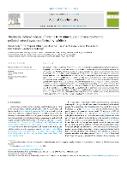| dc.contributor.author | Tuhý, Marek | |
| dc.contributor.author | Ettler, Vojtěch | |
| dc.contributor.author | Rohovec, Jan | |
| dc.contributor.author | Stonová, Kateřina | |
| dc.contributor.author | Matoušková, Šárka | |
| dc.contributor.author | Drahota, Petr | |
| dc.contributor.author | Sullivan, Andrew L. | |
| dc.date.accessioned | 2025-04-17T11:41:05Z | |
| dc.date.available | 2025-04-17T11:41:05Z | |
| dc.date.issued | 2025 | |
| dc.identifier.uri | https://hdl.handle.net/20.500.14178/3079 | |
| dc.description.abstract | Fire-induced arsenic (As) emission from contaminated biomass or soil is dependent on its solid-phase speciation. To quantify the nature of this release, environmentally relevant As-bearing compounds (sulfides, sulfosalts, As-oxides, arsenates, As-doped Fe-oxyhydroxides and organic material) were experimentally heated with a linear temperature increase (25-800 °C) and simultaneous detection of As and other emitted elements. Organic As-bearing materials (fungi, dimethylarsinic acid-DMAA) exhibited the peak of As release at the lowest temperatures of 275-350 °C, followed by arsenolite (As2O3) with the maximum As emission at ~400 °C. Realgar (As4S4) and orpiment (As2S3) exhibited the maximum As release at 425-450 °C, while enargite (Cu3AsS4) and arsenopyrite (FeAsS) released As at much higher temperatures with emission peaks at ~625 and > 725 °C, respectively. Similarly, As-bearing Fe-oxyhydroxides emitted As at temperatures exceeding 650 °C. Arsenic emission from arsenates was rather variable and peaked at ~700 °C for conichalcite [CaCu(AsO4)(OH)], and scorodite (FeAsO4.2H2O), while for mimetite [Pb5(AsO4)3Cl], it peaked towards the upper limit of the temperature range. These results suggest that typical low intensity wildland fires would affect only organically bound As and arsenolite, while higher intensity wildland fires could cause the redistribution of As from all studied phases, thereby posing a significant environmental risk of As redistribution beyond contaminated sites. | en |
| dc.language.iso | en | |
| dc.relation.url | https://doi.org/10.1016/j.apgeochem.2025.106318 | |
| dc.rights | Creative Commons Uveďte původ 4.0 International | cs |
| dc.rights | Creative Commons Attribution 4.0 International | en |
| dc.title | Thermally-induced release of arsenic from minerals and phases relevant to polluted natural systems affected by wildfires | en |
| dcterms.accessRights | openAccess | |
| dcterms.license | https://creativecommons.org/licenses/by/4.0/legalcode | |
| dc.date.updated | 2025-04-17T11:41:05Z | |
| dc.subject.keyword | arsenic-bearing minerals | en |
| dc.subject.keyword | DMAA | en |
| dc.subject.keyword | thermally induced As emission | en |
| dc.subject.keyword | wildfire | en |
| dc.identifier.eissn | 1872-9134 | |
| dc.relation.fundingReference | info:eu-repo/grantAgreement/MSM//EH22_008/0004605 | |
| dc.relation.fundingReference | info:eu-repo/grantAgreement/UK/COOP/COOP | |
| dc.date.embargoStartDate | 2025-04-17 | |
| dc.type.obd | 73 | |
| dc.type.version | info:eu-repo/semantics/publishedVersion | |
| dc.identifier.doi | 10.1016/j.apgeochem.2025.106318 | |
| dc.identifier.utWos | 001430935100001 | |
| dc.identifier.eidScopus | 2-s2.0-85217977562 | |
| dc.identifier.obd | 662287 | |
| dc.subject.rivPrimary | 10000::10500::10505 | |
| dcterms.isPartOf.name | Applied Geochemistry | |
| dcterms.isPartOf.issn | 0883-2927 | |
| dcterms.isPartOf.journalYear | 2025 | |
| dcterms.isPartOf.journalVolume | 182 | |
| dcterms.isPartOf.journalIssue | March | |
| uk.faculty.primaryId | 115 | |
| uk.faculty.primaryName | Přírodovědecká fakulta | cs |
| uk.faculty.primaryName | Faculty of Science | en |
| uk.department.primaryId | 1063 | |
| uk.department.primaryName | Ústav geochemie, mineralogie a nerostných zdrojů | cs |
| uk.department.primaryName | Institute of Geochemistry, Mineralogy and Mineral Resources | en |
| dc.type.obdHierarchyCs | ČLÁNEK V ČASOPISU::článek v časopisu::původní článek | cs |
| dc.type.obdHierarchyEn | JOURNAL ARTICLE::journal article::original article | en |
| dc.type.obdHierarchyCode | 73::152::206 | en |
| uk.displayTitle | Thermally-induced release of arsenic from minerals and phases relevant to polluted natural systems affected by wildfires | en |

